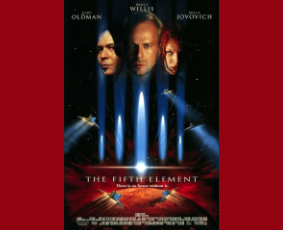The Fifth Element, France 1997. Directed and story by Luc Besson, screenplay by Luc Besson and Robert Mark Kamen.
CineStar Theater 5, Row 3, Seat 8. 20th Anniversary Digital Remaster (2017), original version.
(This post also appears, in slightly different format, at my Instagram account betweendrafts.)
I watched The Fifth Element twenty-seven years ago, and I’m still not a fan. However, this time I enjoyed the set designs, fashion work, and undocked silliness of it all a lot more.
The script scrounges bits & pieces from every movie on Earth for a boiling stew precariously held together by Giraud’s and Mézières’s concept art and an exhaustively bonkers story Besson conceived of when he was sixteen years old, which shows. Also, apparently, Besson created this movie as a kind of time capsule, to contain and preserve every known stereotype known to Western civilization that later generations can marvel at.
But yes, it’s entertaining!
Show stealers are Tucker, Maïwenn/Mula, and Gaultier’s incredible costumes that try their best to undercut the movie’s blazing stereotype brawnfest.
Concerning Prince’s involvement, assertions abound from Besson having been “inspired” by him for the Ruby Rhod character (as to French Wikipedia and an ealier version of an IMDb trivia entry); to Prince being unavailable for scheduling reasons (as to Besson on Twitter in 2016); to Prince turning down the role because he disliked its “effeminate costumes” (as to Tucker in a 2005 Ultimate Edition featurette and—more embellished—in a 2023 The Hill episode that was recently scrubbed from YouTube, sadly). Go figure!
Sound design and Arbogast’s cinematography are superb, but what stands out most is Landra’s microprecision editing that gives the movie its great pacing and exhilarating beats.
Finally, there’s Giraud & Jodorowsky’s lost plagiarism lawsuit, which was pretty rich. Narratively, yes, L’Incal motifs come to mind, but they’re really trivial. And on the art side—well, Giraud was one of the movie’s concept artists, for for crying out loud! But now you might say, what about the striking similarities to the “Harry Canyon” part from the 1981 Heavy Metal movie? Well, Goldberg & Blum’s “Harry Canyon” script was based on the 1975 comic “The Long Tomorrow” (Métal hurlant No.7 May & No.8 June 1976; Heavy Metal Vol.1 No.4 July & No.5 August 1977). Which was written by Dan O’Bannon (yes, that Dan O’Bannon) and drawn by, you guessed it, Giraud while working with Jodorowsky on the aborted Dune movie.
Soooo—what goes around comes around, and next time Giraud should consider sueing his own ass directly to make everything a lot simpler for everybody.
________________
All Movie Reviews
If you have something valuable to add or some interesting point to discuss, I’ll be looking forward to meeting you at Mastodon!

